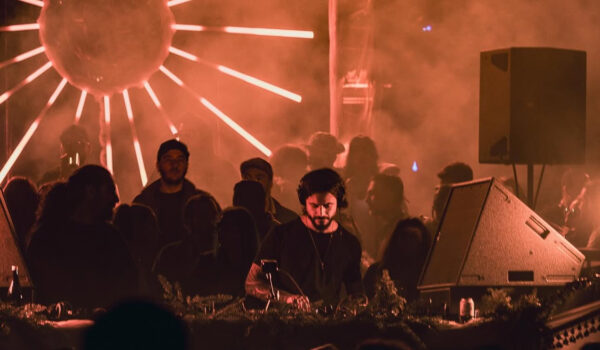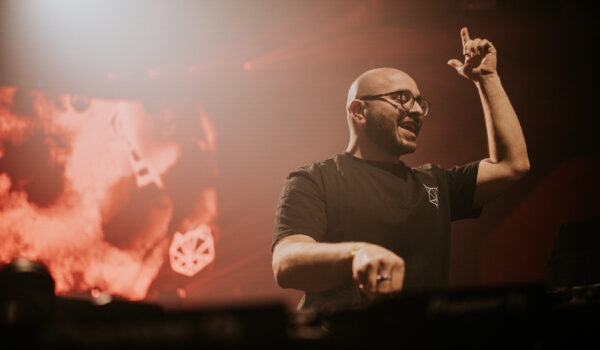Vinyl Mode has been turning heads across the region, especially after the release of his track Shoft Al Halla featuring Moayad — a track that made serious waves in the scene and cemented his name in a whole new way. Now, he’s back with a fresh remix for Husa & Zeyada, blending classic house influences with his signature sound. We caught up with him to talk about the remix process, the story behind his Vibe Generator concept, and what makes the Saudi underground scene such a powerful force.
How would you describe your sound in your own words?
Uplifting, deep, and funky, influenced by 90’s Chicago and Detroit house music. I love badass and flirty vibes and expressions in music, and I try to bring it to my music these days.
People call you The Vibe Generator. Can you tell us why, and where the idea came from?
It’s a long story, and I’m happy to share it with you! It started during my art residency in Paris at Cité Internationale des arts in 2019 when I had my first open studio. I named it “Vibe Generators.” The project I was working on was collaborative art where I performed a musical journey for 10 straight hours while other artists created works in different categories based on the vibe they got from the music I played.
The work they created by the end of the session represented the actual vibe and how it looked; we can never see energy as it flows around us, but we can only feel it. So, I wanted to create something where we could see the vibe via an installation. I am inspired by many artists worldwide, and I also see them as vibe generators. I believe each one of us is a vibe generator, but we only need to find our spark and learn how to use it with love and passion. That way, anyone around us can feel this vibe, whether it’s someone cooking delicious food, painting, or singing. There is always energy generated, but not everyone understands this.

Your new remix for Husa & Zeyada feels like a perfect reflection of your style while still honoring the spirit of the original. Can you walk us through your creative process?
First of all, I am grateful for having worked on this piece of art, as I personally admire Adam and Rola, and I’m a big fan of their work. By now, we have also become good friends. The idea started when Adam shared this album with me a while back, and something pulled me to it—it was just a feeling. I thought I’d give it a shot and asked Adam if I could do the remix. I didn’t have any plan for how I would approach it in the beginning, especially since it’s a different genre. The first thing I thought was, how can I bring this into my world of sound and suit it with my vibe? Usually, when I work with vocals, I start by laying down the vocals at the tempo I want and try to make it blend well with my beat. I see if I can dance with the energy of it. I do this without any melody because I like to feel the power of the words. Based on the feeling I get, I decide where I want to take the harmonic direction. When this step comes, I start by writing the bassline first. For me, the most important elements are a badass bass and a sexy chord/ pad. After I write the bass and start dancing to it along with the vocals, I want to balance it and give it a deep, sexy feeling—that’s where the chord comes to life. I reused a few elements from the original mix in addition to the vocals; I really loved the snare drum—it’s so sexy, mellow, and has a perfect swing. Then I added other elements that I sampled from a garage song from the early 90s. Once I have the first export, The final step is bringing it to my playground when I’m performing to see how it resonates with other people. I observe and adapt, making some changes along the way based on the big sound system or the vibe I see on the dance floor. That’s my process.
Were there any unexpected challenges or surprises while working on the remix?
Not at all, but usually, I don’t like to rush things. I start with sketching a few ideas and sleep on them. Sometimes I may park the project for a month or two, even longer—it only depends on how I feel. I think with this project, I spent more time layering the vocals until I got to where I wanted.
How has your approach to music production evolved since you first started?
It’s been evolving every day. I always feel I need to learn more and more, so I keep my ears open to music. I learn from my friends and artists I admire; it’s never enough, and I will keep learning to express my feelings in music better until my last breath!

In what ways has the underground scene in Saudi Arabia shaped your sound over the years?
In so many ways! I grew up as an artist in the underground scene, where I was doing everything myself to create a good party—being the DJ, promoter, tech guy, find a sick private house and finally be the guest list manager!
What do you think makes the underground scene in Saudi Arabia so unique and special?
We started with no club scene and zero knowledge about it, and we created our own! What also makes it unique is the sense of community; we all gather in one place, taking some risks, but we do it all for the love of music.
Outside of music, what inspires your creativity the most?
Nature and anything related to it. I am lucky to live by the sea, so this influences my mental health in many ways. Being disconnected from city life and all the industrial vibes makes me calm, happy, and in tune. It clears my mind and my energy. Just spending simple time looking at the sea, breathing fresh air, playing with animals, lying on the grass, or hugging a tree makes me feel in sync with the universe.
What’s one piece of gear, software, or ritual you can’t live without in the studio?
I believe it is a ritual, which I mentioned in the previous answer—being in tune with nature keeps my creative frequency high. This allows me to work on anything, anywhere, with any gear or software available. I believe any sound we can hear is music; everything is music. It only depends on how you choose to hear it!









Comments